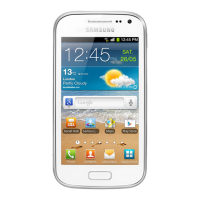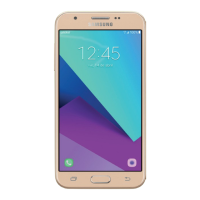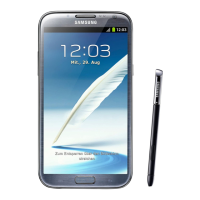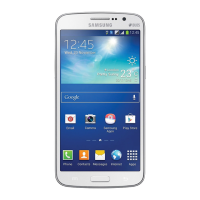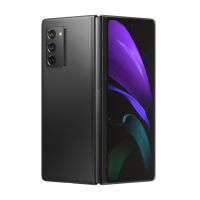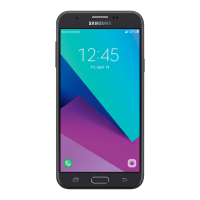Do you have a question about the Samsung Galaxy Pocket 2 and is the answer not in the manual?
Guide to unpacking, installing SIM/battery, and initial power-on procedures.
Identify key hardware components and understand basic button functions.
Learn to insert, remove, and format memory cards for storage expansion.
Master touch screen gestures for device navigation and interaction.
Organize and navigate through the device's home and app screens.
Understand status bar icons and manage notifications.
Connect to mobile networks and Wi-Fi for internet access.
Share your device's data connection with other devices.
Personalize device appearance with wallpapers, ringtones, and screen layouts.
Configure screen lock methods and secure your device data.
Transfer data from previous devices and back up important information.
Learn to make, receive, and manage phone calls efficiently.
Manage contacts, send messages, and set up email accounts.
Capture photos/videos, explore modes, and adjust camera settings.
Browse photos/videos in Gallery and access editing options.
Use S Planner, Clock, Calculator, and Voice Recorder for task management.
Utilize Google apps like Maps, Gmail, and YouTube for various functions.
Connect and share data with other devices wirelessly.
Set up and print content wirelessly from your device.
Keep device software updated and back up critical data.
Learn how to reset the device to factory defaults.
Configure wireless, display, and audio settings for optimal device performance.
Manage device security, language preferences, and text input methods.
Enhance usability with TalkBack, gestures, and voice feedback.
Modify font size, screen magnification, and interaction controls.
Resolve issues related to startup, network, touch screen, and freezing.
Troubleshoot camera, file playback, battery, and connectivity issues.
Guide to unpacking, installing SIM/battery, and initial power-on procedures.
Identify key hardware components and understand basic button functions.
Learn to insert, remove, and format memory cards for storage expansion.
Master touch screen gestures for device navigation and interaction.
Organize and navigate through the device's home and app screens.
Understand status bar icons and manage notifications.
Connect to mobile networks and Wi-Fi for internet access.
Share your device's data connection with other devices.
Personalize device appearance with wallpapers, ringtones, and screen layouts.
Configure screen lock methods and secure your device data.
Transfer data from previous devices and back up important information.
Learn to make, receive, and manage phone calls efficiently.
Manage contacts, send messages, and set up email accounts.
Capture photos/videos, explore modes, and adjust camera settings.
Browse photos/videos in Gallery and access editing options.
Use S Planner, Clock, Calculator, and Voice Recorder for task management.
Utilize Google apps like Maps, Gmail, and YouTube for various functions.
Connect and share data with other devices wirelessly.
Set up and print content wirelessly from your device.
Keep device software updated and back up critical data.
Learn how to reset the device to factory defaults.
Configure wireless, display, and audio settings for optimal device performance.
Manage device security, language preferences, and text input methods.
Enhance usability with TalkBack, gestures, and voice feedback.
Modify font size, screen magnification, and interaction controls.
Resolve issues related to startup, network, touch screen, and freezing.
Troubleshoot camera, file playback, battery, and connectivity issues.
| Network | GSM / HSPA |
|---|---|
| 3G bands | HSDPA 900 / 2100 |
| Speed | HSPA 21.1/5.76 Mbps |
| GPRS | Yes |
| EDGE | Yes |
| Weight | 107 g (3.77 oz) |
| OS | Android 4.4.2 (KitKat) |
| GPU | Mali-400 |
| Card slot | microSD, up to 32 GB |
| Internal | 4 GB, 512 MB RAM |
| Primary | 2 MP |
| Video | Yes |
| Secondary | No |
| Alert types | Vibration; MP3, WAV ringtones |
| Loudspeaker | Yes |
| 3.5mm jack | Yes |
| WLAN | Wi-Fi 802.11 b/g/n, Wi-Fi Direct, hotspot |
| Bluetooth | 4.0, A2DP |
| GPS | Yes, with A-GPS |
| Radio | FM radio |
| USB | microUSB 2.0 |
| Sensors | Accelerometer |
| Browser | HTML |
| Java | No |
| Colors | White, Black |
| Status | Available |
| 2G bands | GSM 850 / 900 / 1800 / 1900 |
| SIM | Dual SIM (Mini-SIM, dual stand-by) |
| Type | TFT capacitive touchscreen |
| Resolution | 240 x 320 pixels |
| CPU | 1.0 GHz Cortex-A7 |
| Messaging | SMS(threaded view), MMS, Email, IM |
| Battery | Li-Ion 1200 mAh battery |
| Stand-by | Up to 300 h |

